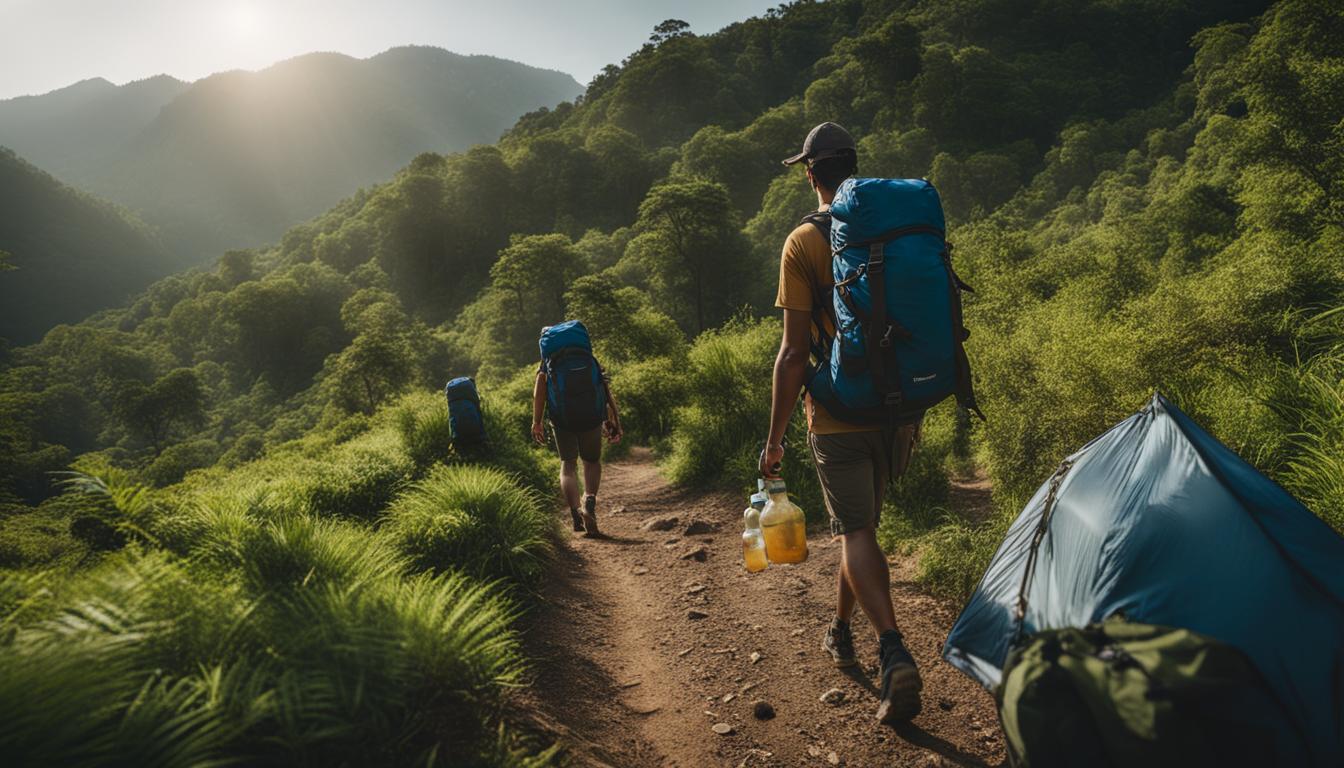Hey there, fellow nature enthusiasts! Are you ready to embark on an eco-friendly backpacking adventure? I’m here to share some invaluable tips and tricks to help you embrace sustainable practices and make a positive impact on the environment while enjoying the great outdoors.
Practicing eco-friendly backpacking means immersing yourself in nature while leaving only footprints and taking unforgettable memories. By embracing sustainable backpacking practices, you can ensure that your outdoor adventures are not only fulfilling but also eco-conscious. So, let’s dive in and discover how you can make your backpacking journey green and sustainable!
Key Takeaways:
- Choose an eco-friendly campsite with sustainable practices.
- Pack eco-friendly gear made from sustainable materials.
- Embrace the Leave No Trace principles for minimal impact.
- Reduce your carbon footprint while backpacking.
- Contribute to the preservation of nature for future generations.
Choose an Eco-Friendly Campsite for a Sustainable Adventure

When it comes to eco-friendly backpacking, selecting the right campsite is crucial. By choosing an eco-friendly campsite, you can ensure that your outdoor adventure aligns with your sustainable values and reduces your carbon footprint. Look for campsites that prioritize sustainability and have integrated environmentally-friendly practices.
These campsites often provide recycling facilities, use solar power for amenities, and have a commitment to minimizing their environmental impact. Campgrounds with eco-certifications, such as LEED (Leadership in Energy and Environmental Design) or Green Key, are excellent options to consider. These certifications demonstrate that the campsite meets strict environmental standards and practices. By supporting eco-friendly campsites, you contribute to environmental conservation efforts and ensure a more sustainable backpacking experience.
Benefits of Choosing an Eco-Friendly Campsite:
- Reduced carbon footprint
- Support for environmental conservation
- Access to sustainable amenities
- Opportunity to learn about eco-friendly practices
“Choosing an eco-friendly campsite not only reduces your impact on the environment but also supports establishments that actively contribute to environmental conservation.”
When researching potential campsites, look for information on their sustainability initiatives, such as waste management practices, energy conservation efforts, and water conservation measures. Reviews and testimonials from other backpackers can also provide valuable insights into a campsite’s commitment to sustainability. By choosing an eco-friendly campsite, you can enjoy a more environmentally-conscious backpacking adventure while immersing yourself in nature’s beauty.
| Key Features of an Eco-Friendly Campsite | Benefits |
|---|---|
| Recycling facilities | Minimize waste and promote recycling |
| Solar-powered amenities | Reduce reliance on non-renewable energy sources |
| Commitment to minimizing environmental impact | Preserve natural resources and protect wildlife habitats |
| Eco-certifications (LEED, Green Key) | Ensure adherence to strict environmental standards |
Pack Eco-Friendly Gear to Minimize Waste
When embarking on an eco-friendly backpacking adventure, it’s essential to pack gear that aligns with your commitment to sustainability. By choosing eco-friendly gear, you can minimize waste and reduce your environmental impact. Here are some tips for packing gear that is both functional and environmentally conscious.
Choose Gear Made from Sustainable Materials
Opt for gear that is made from sustainable materials, such as recycled fabrics. Many outdoor brands now offer products made from recycled plastics, which helps reduce the demand for virgin materials and decreases waste in landfills. By choosing gear that utilizes sustainable materials, you can contribute to the circular economy and promote a more environmentally friendly outdoor industry.
Opt for Reusable Items
Another way to minimize waste is by packing reusable items. Instead of single-use plastic water bottles, bring a durable and reusable water bottle that can be refilled throughout your trip. Consider investing in a high-quality water filtration system to ensure a continuous supply of clean water during your backpacking adventure. Additionally, pack reusable food containers, utensils, and cloth napkins to eliminate the need for disposable alternatives.
Use Eco-Friendly Hygiene Products
Personal hygiene is important even while backpacking, but it doesn’t mean you have to compromise your eco-friendly principles. Opt for biodegradable soaps, shampoos, and toothpaste to minimize the impact on water sources and ecosystems. Avoid products that contain harmful chemicals and choose brands that prioritize sustainability and environmental responsibility.
Reduce Packaging Waste
Before heading out on your backpacking trip, take the time to carefully consider the packaging of the items you’re bringing. Remove excess packaging and unnecessary plastic wrappers to reduce the amount of waste you’ll generate during your journey. If possible, choose products with minimal packaging or opt for bulk options that eliminate the need for individual packaging altogether.
By packing eco-friendly gear and being mindful of your consumption and waste, you can minimize your environmental impact while enjoying the beauty of the great outdoors. Embrace the principles of sustainability and leave only footprints behind on your eco-friendly backpacking adventure.
| Eco-Friendly Gear Packing Checklist |
|---|
| Reusable water bottle |
| Water filtration system |
| Reusable food containers |
| Reusable utensils |
| Cloth napkins |
| Biodegradable soaps, shampoos, and toothpaste |
Embrace Leave No Trace Principles for Minimal Impact
When embarking on an eco-friendly backpacking adventure, it’s crucial to embrace the Leave No Trace principles. These principles provide valuable guidelines for minimizing our impact on the environment and ensuring the preservation of wild spaces for future generations to enjoy.
1. Plan ahead and prepare: Before setting off on your backpacking journey, research and familiarize yourself with the area’s regulations and restrictions. This will help you make informed decisions and ensure that you’re adequately prepared for the trip.
2. Travel and camp on durable surfaces: Stick to established trails and campsites to avoid damaging fragile ecosystems. By staying on durable surfaces like rocks or gravel, you can minimize soil erosion and preserve vegetation.
3. Dispose of waste properly: Pack out all trash and litter, leaving no trace behind. Dispose of waste in designated containers or bring it back with you. Avoid burying trash, as it can end up in water sources and harm wildlife.
4. Leave what you find: Resist the temptation to take natural mementos from the wilderness. Leave rocks, plants, and other natural features as you found them, allowing others to experience the beauty of the untouched environment.
5. Minimize campfire impact: Only build campfires in designated fire rings or use a camping stove as an alternative. Keep fires small and ensure they are completely extinguished before leaving the site.
6. Respect wildlife: Observe wildlife from a distance and avoid approaching or feeding them. Do not disturb nesting areas or habitats, and keep your food properly stored to prevent attracting animals.
7. Be considerate of other visitors: Maintain a peaceful and respectful atmosphere by keeping noise levels low and allowing others to enjoy the tranquility of the outdoors. Yield to fellow hikers on the trail and respect their right to a positive outdoor experience.
By embracing these Leave No Trace principles, we can ensure that our backpacking adventures have minimal impact on the environment. Let’s strive to leave only footprints and memories while preserving the natural beauty of our wilderness.
What Are Some Eco-Friendly Practices That Can Be Incorporated Into Backpacking?
When backpacking, using a reusable water bottle and food containers is one of the best ecoconscious backpacking practices. Additionally, choosing a campsite that has already been used, packing out all trash, and using biodegradable soaps are also great ways to minimize environmental impact while enjoying the great outdoors.
Conclusion: Journey Towards an Eco-Friendly Backpacking Adventure
Now that we have explored the various tips and practices for eco-friendly backpacking, it’s time to embark on your sustainable outdoor adventure. By incorporating eco-conscious habits into your backpacking journey, you can make a positive impact on the environment while enjoying a fulfilling experience in nature.
Start by choosing an eco-friendly campsite that aligns with sustainable practices. Look for recycling facilities, solar-powered amenities, and a commitment to minimizing the environmental impact. Supporting establishments that prioritize sustainability not only reduces your carbon footprint but also contributes to environmental conservation.
Packing eco-friendly gear is another vital aspect of practicing sustainable backpacking. Opt for gear made from recycled materials and choose reusable items like water bottles to minimize waste. Consider using biodegradable soaps and other eco-friendly alternatives for personal hygiene. These small choices can have a big impact on reducing your environmental footprint.
Lastly, don’t forget to embrace the Leave No Trace principles. Plan ahead and prepare, travel and camp on durable surfaces, dispose of waste properly, and respect wildlife and other visitors. By following these guidelines, you can ensure that you leave only footprints and memories behind while preserving the beauty of natural spaces for future generations.
Remember, an eco-friendly backpacking adventure is not only about protecting the environment but also about immersing yourself in nature and rejuvenating your soul. So, pack your sustainable gear, choose an eco-friendly campsite, and embrace the principles of Leave No Trace. Let nature inspire and guide you on a journey towards a greener and more fulfilling backpacking experience.

